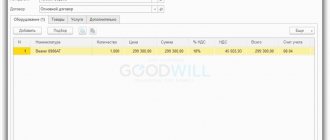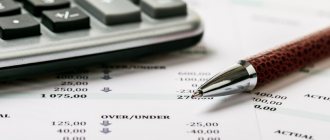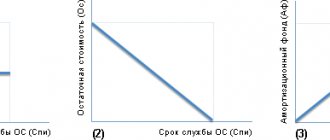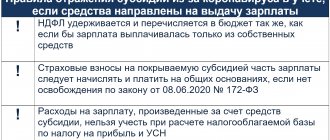Tutorial 1C: Accounting 8
In the last lesson, you and I learned how to arrive at inventory items, extras. expenses and services. In this lesson we will continue the topic of acquiring material assets and look at how fixed assets are received by the company. Let's learn how to put them into operation.
We will begin our study of the fixed asset accounting block in the 1C Accounting 8 program with the main reference books related to fixed assets. This is the directory “Fixed Assets” - which contains a list of fixed assets and the directory “Methods of reflecting expenses”, which contains the rules for calculating depreciation on enterprise expenses. Let's get acquainted with other directories in the section related to fixed assets. We will perform the basic operations of purchasing fixed assets that do not require installation. Let's put them into operation. Let's get acquainted with the calculation of depreciation in the 1C Accounting 8 program. At the end, we will complete a practical task.
Sources of investment
Financial injections into fixed assets come from two sources:
- own funds;
- attracted investments.
The first group includes the company’s income and deductions for depreciation of fixed assets. Raised funds are formed from:
- bank loans;
- loans from other organizations;
- budget resources;
- private finance;
- investment investments of different levels.
According to statistics conducted by Rosstat, the preferred goals for investment are:
- Installation of new equipment – 65% of enterprises
- Automation of the production process – 45%
- Reduced cost of production – 39%
- Reduced electricity consumption – 40%
- Modernization of the technological process – 35%
- Environmental protection – 32%
- Increase in the number of products produced – 30%
- Attracting new personnel – 20%
Taking into account all the points described above, we can firmly state that without a sufficient amount of investment in fixed capital, an increase in the economic viability of the enterprise, an increase in profits and production volume is unlikely.
Directory "Fixed assets".
Let's start studying fixed asset accounting in the 1C Accounting 8 program with reference books. Let's go to the "Reference books" section, "OS and intangible assets" group. Let’s select the directory “Fixed Assets”.
The directory is intended to store a list of fixed assets and information about them.
Information about the fixed asset is filled in upon acceptance for accounting and may change during operation.
The directory has a multi-level, hierarchical structure. To classify fixed assets, you can create groups and subgroups.
When you enter a fixed asset, an inventory number is automatically assigned.
On the Basic Information , you can manually fill in the data:
- Full name - the name of the main tool for filling out printed forms.
- Manufacturer, serial number, passport number, date of manufacture (construction).
- Fixed asset accounting group - category of fixed asset, for example, Buildings, Structures, Transfer devices, etc.
- Type of fixed asset - type of fixed asset: direct fixed asset or capital investment in leased property.
- Depreciation group - depreciation group of a fixed asset.
- OKOF , Code according to ENAOF .
- The Motor transport checkbox is set for motor vehicles.
- Location address and region code.
The Accounting and Tax Accounting tabs contain information on accounting and tax accounting of fixed assets. This information is filled in automatically after the fixed asset is accepted for accounting and put into operation.
You can register the acceptance of a fixed asset for accounting on the Accounting using the hyperlink Enter a document of acceptance for accounting .
An inventory card of a fixed asset (form OS-6) can be generated by clicking the Form OS-6 .
You can add a group of fixed asset objects of the same type, differing only in inventory numbers, to the directory by clicking the Group addition .
In the form that opens, you must indicate:
- The code from which numbering will begin is
- Number of elements created,
- Name of fixed assets.
You can also fill in other information that is common to the objects you are adding.
The number of added objects is limited by the bit depth of the code. For example, specifying the start code 01 means that no more than 99 directory entries can be added automatically. If you want to add more elements in batches, you must add enough bits to the initial code.
Group addition of directory elements is done by clicking the Add . All elements will have the same names and contain the information specified in the fields of the group addition form.
To quickly fill out documents with similar fixed asset objects that have the same names, you need to enter at least one such object into the tabular section. The list of fixed assets will be filled with objects that have the same name as the one originally entered, by clicking the Fill - By name command panel of the tabular section.
The essence of investment
The main task of any enterprise is to make a profit.
In addition to a powerful marketing strategy, this requires a high-quality final product that will conquer a permanent market. To get ahead of competitors and stay on top, the work of an enterprise requires constant updates:
- installation of modern equipment, which often leads to speeding up the production process and reducing costs;
- introduction of new technologies to improve product quality;
- launch of a new production line to expand the range.
In addition, in the process of work, equipment, machines, premises, machines and other objects that are part of the organization’s fixed assets wear out. All this requires investing money in restoring and updating work tools.
Investments in fixed assets are represented by:
- Construction of new buildings, current and major repairs of existing premises;
- Purchase and installation of new equipment;
- Updating tools and household equipment;
- Purchasing new vehicles for the company;
- Issue of securities (bonds, company shares) and their sale in order to attract additional capital for development;
- Brand development, obtaining a patent or registration of copyright.
All these actions are aimed at increasing the efficiency of the company. At the same time, this category does not include:
- purchase of fixed assets that were used by other companies;
- purchasing apartments in multi-storey residential buildings;
- purchase of land;
- expenses for obtaining a license permit, rent, advertising.
Directory "Methods of reflecting expenses."
The directory is located in the “Directories” section, the “Income and Expenses” group.
The directory is intended to store a list of possible ways to reflect depreciation expenses (repayment of cost) in the costs of the enterprise.
The method of reflecting depreciation expenses is indicated when accepting a fixed asset for accounting, when accepting an intangible asset for accounting, when indicating the purpose of use of work clothes and special equipment.
When entering a method for reflecting depreciation expenses, you must specify the accounting and tax account and the corresponding analytics according to which the depreciation amount should be distributed.
Depreciation costs can be distributed in a certain proportion across several cost items and analytical objects, for example, across several divisions of the organization. To do this, you need to set the values of the distribution coefficients in the K . When calculating the amount of depreciation, the values of the specified coefficients are summed up, and then the amount of depreciation is distributed proportionally to the value of each coefficient.
By default, several elements have already been created in it and note that they are called Depreciation (account 20.01), Depreciation (account 26), Depreciation (account 44).
Case two: we bought it, use it, but didn’t make a profit
A variation of the situation described above is the use of property in an activity that has not generated income. For example, it was rented out, but the tenant did not pay the amounts due.
Here we are again faced with the wording of paragraph 1 of Article 256 of the Tax Code of the Russian Federation, which states that only those used to generate income are recognized as depreciable property. It turns out that since de facto the property was not used in income-generating activities, then it is not depreciable and all accrued depreciation must be withdrawn from expenses.
However, here, unlike the situation with unused property, the courts take a more favorable position for the taxpayer. According to the judges, the main thing is that the property is, in principle, involved in the activities of the organization, which should potentially generate income. And whether income is actually received or not is not important (see, for example, Resolutions of the FAS Volga District dated December 6, 2007 in case No. A65-9440/2007-SA2-11 and FAS Ural District dated December 10, 2007 No. Ф09-10116/ 07-C2 in case No. A76-2212/07).
Other reference books and documents from the section “Fixed Assets”
They may be hidden by default. If the directory is not displayed in the navigation panel, use the “Navigation settings” command in the right corner. In the left window we present available reference books. On the right are directories that are displayed in the navigation panel. Let's find the "OS and Intangible Materials" group and move all the directories to the right window. Now in the navigation panel in the “OS and intangible assets” group I have significantly more reference books presented. Let's get to know them.
Construction objects - the directory is intended to store a list of fixed assets under construction (modernized, reconstructed, installed).
Information register “OKOF depreciation groups” - the register sets the applied depreciation groups for the OKOF classifier element.
The directory “Annual fixed asset depreciation schedules” is intended for storing depreciation schedules for fixed assets in organizations with a seasonal nature of production.
The use of a depreciation schedule is indicated when accounting for a fixed asset.
The use of a depreciation schedule after accepting a fixed asset for accounting or a change in the depreciation schedule is registered in the document Change of fixed asset depreciation schedules.
When entering a schedule, you need to specify the distribution coefficients of the annual depreciation amount by month. The distribution coefficient will be taken into account when performing a routine depreciation operation.
The ENAOF directory contains a classifier of fixed assets for which standard codes and annual depreciation rates are established.
This directory classifies fixed assets for which depreciation is calculated according to ENAOF.
For motor vehicles, depreciation rates are used as a percentage of the cost of the car per 1000 km.
Code for ENAOF is indicated for fixed assets in the Code for ENAOF .
The OKOF directory contains an all-Russian classifier of fixed assets.
The directory is used to classify fixed assets when accepted for accounting to determine the depreciation group.
The OKOF code is indicated for the fixed asset in the OKOF .
The directory “Parameters for the production of fixed assets” is intended for storing a list of natural indicators, in proportion to the volume of which depreciation of fixed assets can be calculated.
The directory “Reasons for writing off fixed assets” is intended to store a list of reasons for writing off fixed assets.
Directory “Events with fixed assets” - is intended for storing a list of events with fixed assets of the organization, for example, acceptance for accounting, relocation, modernization, etc.
For each event, you must select Event Type .
When registering fixed asset accounting documents, a value from the reference book is selected in the Event .
The document “Receipt (act, invoice)” is intended to reflect various operations for the receipt of goods and services.
Document “Receipt of additional expenses" - is intended to reflect the services of third-party organizations, the costs of which are included in the cost of goods.
The document “Transfer of equipment for installation” is intended to include the cost of equipment and components requiring installation in the costs that form the initial cost of fixed assets.
The document “Receipt (act, invoice)” is intended to reflect various operations for the receipt of goods and services.
The document “Acceptance for accounting of fixed assets” is intended to reflect the acceptance for accounting of fixed assets.
The document “Movement of fixed assets” is intended to reflect the movement of fixed assets to another division and (or) to another financially responsible person.
The document “OS Modernization” is intended to reflect the modernization (reconstruction) of fixed assets.
The document “Inventory of fixed assets” is intended to reflect the results of the inventory of fixed assets.
The document “Write-off of fixed assets” is intended to reflect the write-off of fixed assets.
The document “Preparation for the transfer of fixed assets” is intended to reflect preparation for the transfer of ownership of fixed assets if the sale transaction is subject to state registration.
The document “Transfer of fixed assets” is intended to reflect the sale of fixed assets.
The document “Production of fixed assets” is intended to register the volume of produced products (work performed) for calculating depreciation of fixed assets.
The document “Changing depreciation schedules of fixed assets” is intended for changing depreciation schedules of fixed assets in organizations with a seasonal nature of production.
The document “Changing the special coefficient for calculating depreciation of fixed assets (tax accounting)” is intended for changing the special coefficient for calculating depreciation of fixed assets in tax accounting.
The document “Changing the methods of reflecting expenses for depreciation of fixed assets” is intended to change the method of reflecting expenses for depreciation of fixed assets - cost accounts and analytics, which include expenses for depreciation of fixed assets.
The document “Changing the parameters for calculating depreciation of fixed assets” is intended for changing the parameters for depreciation of fixed assets.
The document “Change in the state of fixed assets” is intended to suspend or resume the calculation of depreciation on fixed assets.
The document “Registration of payment for fixed assets and intangible assets for the simplified tax system” is intended for registration in the tax accounting of the simplified tax system of information on payment to the supplier of fixed assets, intangible assets and modernization costs.
The document “Registration of payment for fixed assets and intangible assets (IP)” is intended for registration in the accounting of individual entrepreneurs of information on payment to the supplier of fixed assets and intangible assets.
The report “Fixed assets depreciation sheet” is intended for analyzing data on fixed assets. In the report, you can analyze accounting and tax accounting data, set a selection by materially responsible person, display the date of acceptance for accounting, etc.
The report “Inventory book of fixed assets” - an inventory book of accounting for fixed assets in the OS-6b form (approved by Decree of the State Statistics Committee of Russia dated January 21, 2003 No. 7) is used by small enterprises to record the availability of fixed assets, as well as their movement within the organization. The inventory book is kept in the accounting department of the organization in one copy.
Where and how to find investors
An enterprise can find financial support from credit institutions, investment funds, and private investors.
The main condition for success is the competent attraction of those wishing to invest money in a specific enterprise.
For this, it is important that the investment project has a certain attractiveness, which can be achieved with a high level of efficiency.
So, the main task is to find people who will willingly invest money in the company’s fixed capital. To do this, you need to be able to advertise your organization, draw the attention of potential investors to all the advantages of cooperation with your company:
- Present a transparent business plan indicating the current state of affairs and future development trends. Moreover, it must contain a detailed description of all stages.
- Please note the importance of a correctly completed package of documents. Investors will also need the company's current accounts.
- Create attractive terms of cooperation. This could be an offer to take part in the management of the company, providing additional privileges.
- Give an interesting presentation and clearly demonstrate the benefits of your project.
After successfully searching for those interested in financial investments, we can safely say about positive trends in the further development of the enterprise.
Receipt of fixed assets
Let's move directly to accounting for fixed assets and create the first document related to the receipt of fixed assets in our company.
Go to the “OS and Intangible Materials” section of the “Equipment Receipts” magazine. Let's create our first document:
We receive equipment from the supplier:
- Invoice 1501 dated 01/15/2015, invoice 1501 dated 01/15/2015
- Supplier LLC "KVADROKOM" INN/KPP: 5027147377/ 770301001
- OGRN: 1095027003367
- Address 123242, Moscow, Sadovaya-Kudrinskaya street, building No. 11, building 1, apartment Room 2P-14
- Automatic striping machine. EXS 108 1 pc. RUB 1,180,000.00 each
Total: RUB 1,180,000.00 incl. VAT 180,000.00
Acceptance for accounting of fixed assets that do not require installation
Now we need to put the acquired fixed asset into operation. To do this, a document “Acceptance for accounting of fixed assets” is created in the 1C Accounting 8 program. You can create it in the journal of documents of the same name.
We will formalize the acceptance for accounting of the OS:
- Date: 01/31/2015
- MOL: director
- Location: Production workshop
- Equipment: Automatic striping machine. EXS 108
- Main tool: Automatic striping machine. EXS 108 OS accounting group: Machinery and equipment (except office)
- Depreciation group: Fourth group (over 5 years up to 7 years inclusive)
- Manufacturer: Factory
- Serial number: 1111
- Passport number (registration): 222
- Release (construction) date: 01/01/2015
- Method of receipt: Purchase for a fee
- The procedure for including cost in expenses: Calculation of depreciation
Conclusion
Of course, investing in fixed capital can be defined as a painstaking and troublesome way to expand a business, attract new partners, and increase the profitability of an enterprise. For a favorable outcome, having received funds, you need to correctly distribute investments. But first, it is advisable to conduct a thorough analysis of all aspects of the transaction and only after that make an informed decision.
It’s interesting to know what ways to increase your income do you know? Be sure to write about it in the comments and rate our work! And if you know someone who would benefit from this article, please share it! And this person will definitely tell you: “Thank you!”







